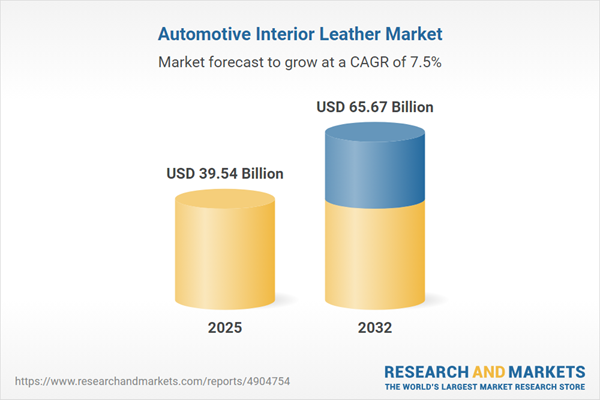Speak directly to the analyst to clarify any post sales queries you may have.
The automotive interior leather market is evolving rapidly, shaped by innovation, stringent regulations, and changing consumer demands. Senior executives looking to navigate this shifting terrain must understand the core drivers, from regulatory flux to advances in material science, that are redefining market opportunity and competitive positioning.
Market Snapshot: Growth Trajectory and Competitive Landscape
The automotive interior leather market is experiencing strong expansion, with revenues moving from USD 36.74 billion in 2024 to USD 39.54 billion in 2025. The sector is projected to sustain a compound annual growth rate (CAGR) of 7.52%, reaching USD 65.67 billion by 2032. This upward momentum is driven by rising demand for premium, sustainable materials, ongoing advances in processing technologies, and the expanding role of leather in differentiating vehicle interiors across regions.
Scope & Segmentation
This report delivers comprehensive insight for stakeholders across the value chain, covering product, application, and geographical segments.
- Leather Types: Genuine leather—full-grain, split, and top-grain—along with polyurethane and polyvinyl chloride leather.
- Raw Material Origins: Full-grain, split, and top-grain hides.
- Price Ranges: Economy, mid-range, and premium categories.
- Vehicle Types: Commercial vehicles, off-road vehicles, and passenger cars.
- Application Areas: Door panels, gear knobs, seats, steering wheels.
- Regional Coverage: Americas (with breakdowns for North America and Latin America), Europe, Middle East & Africa, and Asia-Pacific markets.
- Leading Companies Analyzed: Adient plc, Lear Corporation, Eagle Ottawa, DK Leather Corporation, Scottish Leather Group, Wollsdorf Leder Schmidt & Co Ges, Classic Soft Trim, Katzkin Leather Inc, Kuraray Plastics.
Emerging technologies such as bio-based tanning, digital traceability, and advanced synthetic materials are also examined, offering actionable insights on how suppliers are responding to customer preferences and regulatory imperatives.
Key Takeaways: Strategic Insights for Automotive Interior Leather Market
- Growing consumer emphasis on both comfort and sustainability is elevating the significance of ethically sourced, low-impact leather and alternative materials.
- Original equipment manufacturers (OEMs) and material suppliers are collaborating to innovate in tanning processes while integrating functionalities such as antimicrobial coatings and digital customization.
- Regional trends reveal that premiumization in developed economies coexists with mass-market adoption of cost-effective synthetics in emerging regions, highlighting the importance of flexible segmentation strategies.
- Recent trade measures have impacted sourcing decisions and heightened the urgency for tariff optimization and resilience in supply chain design.
- Stakeholders leveraging digitalization for traceability and predictive quality control are better equipped to address market complexity and reduce operational risks.
Tariff Impact: Navigating Regulatory and Cost Realignments
Recent changes to United States tariff regulations have increased cost pressure on automotive leather imports and created new supply chain complexities. These adjustments are forcing manufacturers to optimize sourcing, explore alternative materials that fall outside tariff categories, and invest in localized processing to control costs and manage lead times. Strategies such as supplier diversification, renegotiated agreements, and digital freight monitoring are becoming central to maintaining margin integrity and supply resilience.
Methodology & Data Sources
This report utilizes a mixed-methods approach, combining in-depth interviews with industry experts, suppliers, and regulatory officials with analysis of industry journals, trade association data, and customs records. Data validation is ensured through triangulation, financial disclosure verification, and scenario modeling to assess policy and market shifts. Analytical frameworks employed include SWOT and PESTEL analyses alongside scenario-based projections.
Why This Report Matters
- Enables informed decision-making on procurement, innovation investment, and supplier selection by synthesizing regulatory, technological, and consumer insights.
- Delivers segment-specific intelligence for targeting growth opportunities across premium, mid-range, and economy tiers in diverse regional markets.
- Equips leadership with actionable strategies to enhance supply chain agility, sustainability, and cost management in response to evolving market and policy factors.
Conclusion
Senior decision-makers can leverage this report to confidently adjust their strategic blueprints. The study provides a reliable foundation for adapting to emerging industry dynamics, optimizing operations, and maintaining a leadership position in the global automotive interior leather market.
Additional Product Information:
- Purchase of this report includes 1 year online access with quarterly updates.
- This report can be updated on request. Please contact our Customer Experience team using the Ask a Question widget on our website.
Table of Contents
3. Executive Summary
4. Market Overview
7. Cumulative Impact of Artificial Intelligence 2025
Companies Mentioned
The companies profiled in this Automotive Interior Leather market report include:- Adient plc
- Lear Corporation
- Eagle Ottawa
- DK leather corporation
- Scottish leather group
- Wollsdorf leder schmidt & Co Ges
- Classic soft trim
- Katzkin Leather inc
- Kuraray plastics
Table Information
| Report Attribute | Details |
|---|---|
| No. of Pages | 187 |
| Published | November 2025 |
| Forecast Period | 2025 - 2032 |
| Estimated Market Value ( USD | $ 39.54 Billion |
| Forecasted Market Value ( USD | $ 65.67 Billion |
| Compound Annual Growth Rate | 7.5% |
| Regions Covered | Global |
| No. of Companies Mentioned | 10 |









